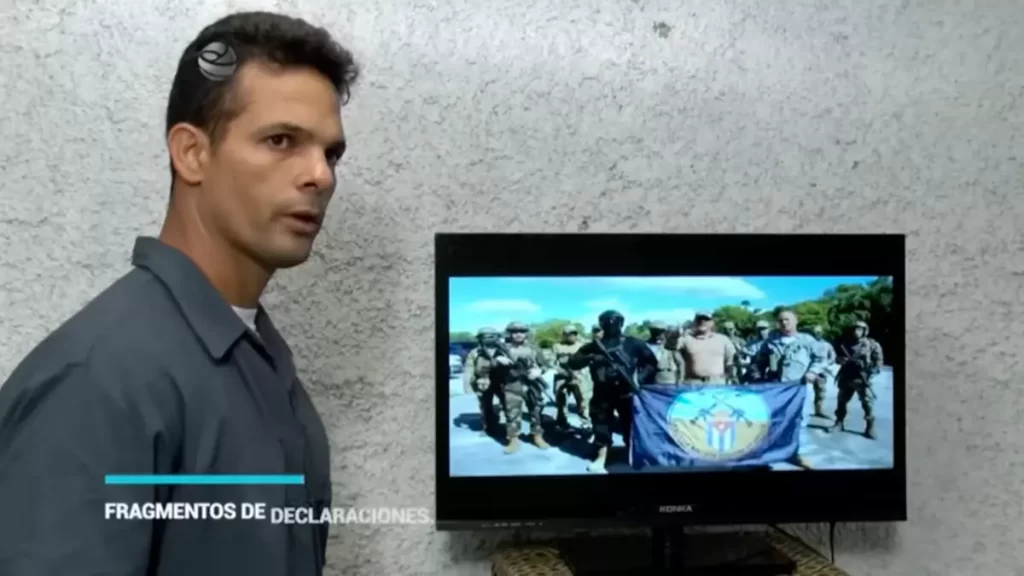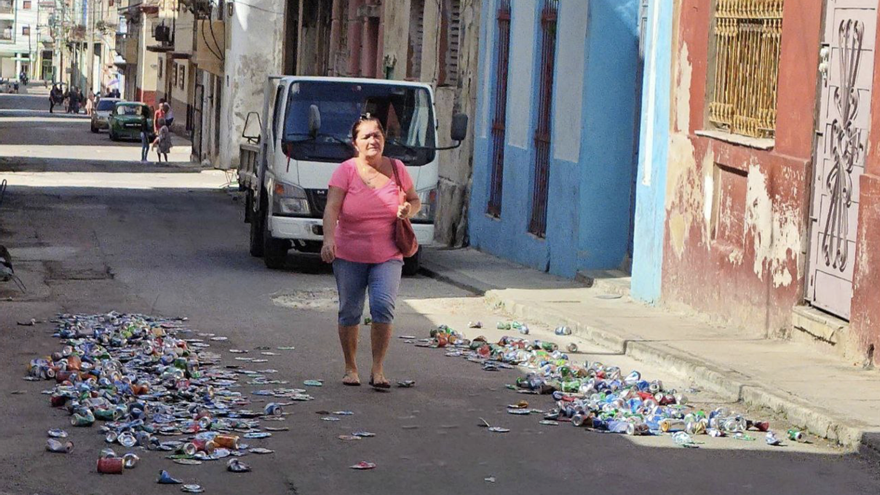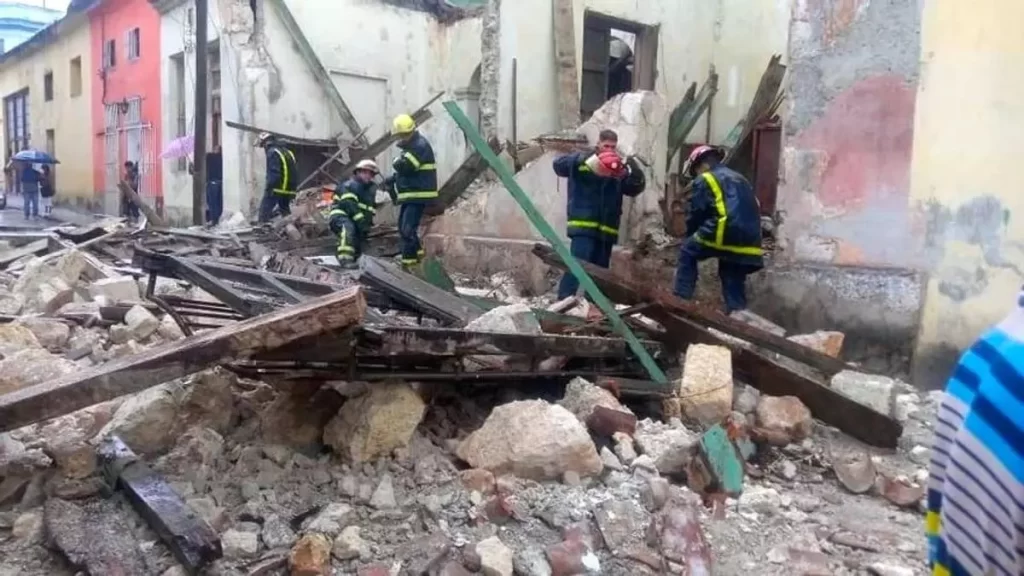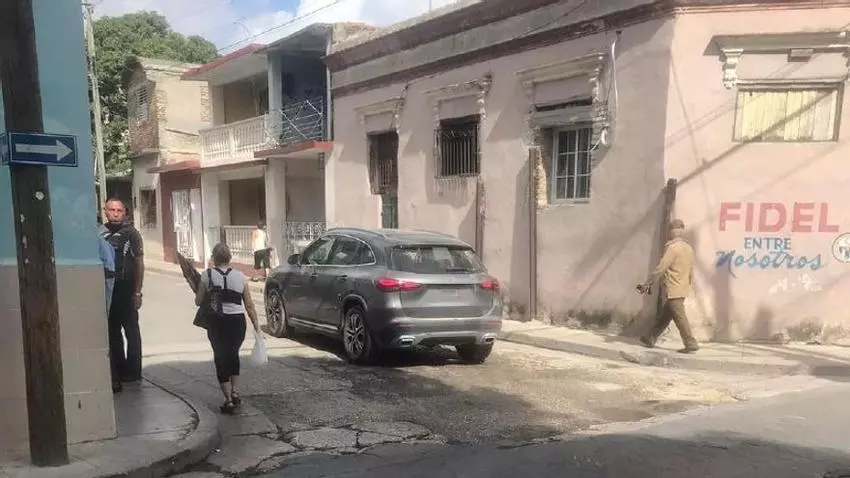Humberto López’s program gave little news, except for the detainee’s statement and his links with the self-styled group “The New Cuban Nation in Arms”

![]() 14ymedio, Madrid, 9 July 2024 – Not much that was new was announced in a national television program which was supposed to reveal details about the “terrorist plot against Cuba, organized and financed from the United States,” which was finally dismantled by the Police and the Armed Forces. The 30 minutes that the special lasted, led by the spokesman of the regime Humberto López, had abundant information about the case that became known last December, when a man was arrested for trying to illegally enter the Island on a jet ski with three pistols, which this Monday became five.
14ymedio, Madrid, 9 July 2024 – Not much that was new was announced in a national television program which was supposed to reveal details about the “terrorist plot against Cuba, organized and financed from the United States,” which was finally dismantled by the Police and the Armed Forces. The 30 minutes that the special lasted, led by the spokesman of the regime Humberto López, had abundant information about the case that became known last December, when a man was arrested for trying to illegally enter the Island on a jet ski with three pistols, which this Monday became five.
The only news was the name of the detainee, who made himself known the day before: Ardenys García Álvarez, a 40-year-old Cienfueguero, allegedly emigrated and resident in the United States since 2014. His statements and the videos and images of the group to which he supposedly belonged were the most spectacular part of López’s program, which had two guests — Colonel Víctor Álvarez Valle and Prosecutor Eduard Roberts Campbell — to give a theoretical basis to what some members of the exile have already considered propaganda to divert attention.
His statements and the videos and images of the group to which he allegedly belonged were the most spectacular part of López’ program
The program began by reviewing the events, which occurred in November, when García Álvarez entered Cuba illegally through Matanzas on a jet ski “with the intention of carrying out violent actions.” A few days later, the famous National List of Terrorists was approved, which includes 61 people – including the politician Orlando Gutiérrez Boronat and the influencer Alex continue reading
García Álvarez, according to his testimony, was a member of one of them, the self-styled New Cuban Nation in Arms, captained by Willy González – who mocked last night’s program on social networks – and who claims that a recruitment group in Florida is willing to use violence to liberate the Island from communism. The group said it was the author in 2022 of the fire against the Provincial Court of Havana, but despite everything, it has only 800 followers.
In the video broadcast by Canal Caribe, García Álvarez recounts how he came into contact with the group through Telegram – although he never indicates if he did it out of conviction or for money – and began to carry out training activities on shooting ranges with several of its members, including Willy González. He also identifies in the photographs Jorge Luis Fernández Figueras El Lobo and Dayan Quiñones, among others.
The individuals appear equipped with a military uniform and the logo of The New Cuban Nation in Arms, which includes the national flag, three stars and two crossed machine guns
The individuals appear in military uniform with the logo of The New Cuban Nation in Arms, which includes the national flag, three stars and two crossed machine guns, and they are seen practicing with weapons that the accused identifies. In another of the fragments, one of them reads a statement: “We, the New Cuban Nation in Arms, believe that the fastest way to achieve it [liberation] is armed struggle, putting the lives of a group of determined men at risk in order to save the lives of many others.”
Humberto López, who describes the fragment as “interesting,” reviews the facts with Colonel Álvarez Valle, including the arrival on the Island of the accused – currently in pretrial detention – on a jet ski with a Florida license plate and “in perfect navigation condition.” In addition to the vehicle, he adds, “a large number of ammunition that had been in a plastic bottle” and scattered by the boat was confiscated, as well as five pistols – which in the December version were three – of the American Tactical brand and two different models of Smith & Wesson, manufactured in the United States, along with a Steyr, from Austria, and a Taurus, created in Brazil. All, the researcher remarked, “were acquired in the United States.”
In addition, the rest of the team had binoculars and wore balaclavas “suitable for violent activity.” López goes so far as to ask – aware of the dubious importance of the story – if a man with this minimum amount of equipment would be dangerous for a country, but those present emphasize that it is not about that but rather about the implications and seriousness of his intentions.
García Álvarez accumulates accusations for multiple crimes, the most serious: acts against state security, punishable by ten to 30 years in prison, life imprisonment or the death penalty.
García Álvarez accumulates accusations for multiple crimes, from illegal entry into the country – which already implies three years in prison -to the most serious: acts against state security, punishable by ten to 30 years in prison, life imprisonment or the death penalty, for “those who violate the territorial space on board a ship or aircraft, clandestinely enter the nation or organize or are part of armed groups to intervene in the commission of crimes contemplated in the Criminal Code.”
Some secondary individuals, also accused, appear in the program, including the father of the main actor, Roberto García Ávila, who was allegedly involved in the son’s plans, and Pavel Fernández Alfonso, with whom he allegedly shared his intentions. Fernández Alfonso had the idea of looking for a farm in which to house more people he would recruit, with particular emphasis on members of the Army, for having training and access to weapons.
The program reserved the final ten minutes to characterize Willy González and broadcast some of the videos he posts on his social networks threatening the Cuban regime, as well as José Luis Fernández El Lobo, to whom several sabotages of the electrical system are also attributed. Both are part, they observed, of the national list of terrorists, and they accused the United States of doing nothing to arrest or extradite* them.
“They are making an effort to ’legitimize’ the list of alleged terrorists in order to continue using it
Humberto López claims, citing a Resolution of the United Nations Security Council, that States must “adopt all measures to pursue investigating and punishing those who are linked” to terrorist acts. Ramón Saúl Sánchez, leader of the Democracy Movement, told Miami television, at the end of the program, “They are making an effort to ’legitimize’ the list of alleged terrorists to be able to continue using it, not only for propaganda but also in possible meetings with the United States.”
Anti-Castrist journalist Ninoska Pérez Castellón, who is also part of the aforementioned list, said on her radio program that this is a new maneuver of the regime, overwhelmed by its internal problems. “It’s all about drawing attention away from the real situation of the country, and this is the kind of thing that worked for them for a while with Fidel Castro. I don’t think it will work for them anymore, given the current situation of the people of Cuba,” she said, adding that the goal is to “calm the population, keep it subdued and make them believe that they are defending it from something monstrous that comes from outside.”
Humberto López, on the other hand, considered his program a public service, despite the fact that nothing was said that was not already known, and the staging indicated more of an effort to generate unity in the face of an alleged external enemy. “Here we are going to continue defending the truth and objectivity of the phenomena. We will continue to look for all the information and make it available to the public. Impunity will never, never be the answer to such serious acts of this nature.” His last sentence, on the other hand, revealed a disturbing glimpse of doubt about the strategy. “I believe that the repudiation of the people of Cuba exists and will continue to be energetic.”
*Translator’s note: Cuba and the U.S. do not have an extradition treaty.
Translated by Regina Anavy
____________
COLLABORATE WITH OUR WORK: The 14ymedio team is committed to practicing serious journalism that reflects Cuba’s reality in all its depth. Thank you for joining us on this long journey. We invite you to continue supporting us by becoming a member of 14ymedio now. Together we can continue transforming journalism in Cuba.




















